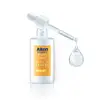What's inside
What's inside
 Key Ingredients
Key Ingredients

 Benefits
Benefits

 Concerns
Concerns

 Ingredients Side-by-side
Ingredients Side-by-side

Water
Skin ConditioningPropanediol
SolventGlycerin
HumectantAscorbyl Glucoside
AntioxidantHyaluronic Acid
HumectantEllagic Acid
Skin ConditioningSodium Hyaluronate
HumectantMannitol
HumectantPhosphatidylcholine
EmulsifyingCholesterol
EmollientDehydroxanthan Gum
Emulsion StabilisingHydrogenated Phosphatidylcholine
EmulsifyingDecyl Glucoside
CleansingXanthan Gum
EmulsifyingSodium Phytate
Sodium Chloride
MaskingSodium Benzoate
MaskingPotassium Sorbate
PreservativeEthylhexylglycerin
Skin ConditioningPhenoxyethanol
PreservativeTriethanolamine
BufferingTocopherol
AntioxidantWater, Propanediol, Glycerin, Ascorbyl Glucoside, Hyaluronic Acid, Ellagic Acid, Sodium Hyaluronate, Mannitol, Phosphatidylcholine, Cholesterol, Dehydroxanthan Gum, Hydrogenated Phosphatidylcholine, Decyl Glucoside, Xanthan Gum, Sodium Phytate, Sodium Chloride, Sodium Benzoate, Potassium Sorbate, Ethylhexylglycerin, Phenoxyethanol, Triethanolamine, Tocopherol
Water
Skin ConditioningMandelic Acid
AntimicrobialMethylpropanediol
SolventAminomethyl Propanol
BufferingSodium Hyaluronate
HumectantXanthan Gum
EmulsifyingDisodium EDTA
Citric Acid
BufferingLactic Acid
BufferingAscorbyl Glucoside
AntioxidantPEG-40 Hydrogenated Castor Oil
EmulsifyingPolysorbate 20
EmulsifyingMelaleuca Alternifolia Leaf Oil
AntioxidantSalicylic Acid
MaskingPhenoxyethanol
PreservativeSodium Metabisulfite
Antioxidant
 Reviews
Reviews

Ingredients Explained
These ingredients are found in both products.
Ingredients higher up in an ingredient list are typically present in a larger amount.
Ascorbyl Glucoside is a stable form of Vitamin C. It is created by combining glucose from starch.
When applied to skin, Ascorbyl Glucoside turns into Ascorbic Acid.
Ascorbyl Glucoside is an antioxidant. Antioxidants help fight free-radicals, or molecules that may damage skin cells.
It can help to reduce redness, improve skin texture, reduce the effects of aging, reduce the visibility of dark spots, and brighten skin.
Read more about other types of Vitamin C:
Learn more about Ascorbyl GlucosidePhenoxyethanol is a preservative that has germicide, antimicrobial, and aromatic properties. Studies show that phenoxyethanol can prevent microbial growth. By itself, it has a scent that is similar to that of a rose.
It's often used in formulations along with Caprylyl Glycol to preserve the shelf life of products.
Sodium Hyaluronate is hyaluronic acid's salt form. It is commonly derived from the sodium salt of hyaluronic acid.
Like hyaluronic acid, it is great at holding water and acts as a humectant. This makes it a great skin hydrating ingredient.
Sodium Hyaluronate is naturally occurring in our bodies and is mostly found in eye fluid and joints.
These are some other common types of Hyaluronic Acid:
Learn more about Sodium HyaluronateWater. It's the most common cosmetic ingredient of all. You'll usually see it at the top of ingredient lists, meaning that it makes up the largest part of the product.
So why is it so popular? Water most often acts as a solvent - this means that it helps dissolve other ingredients into the formulation.
You'll also recognize water as that liquid we all need to stay alive. If you see this, drink a glass of water. Stay hydrated!
Learn more about WaterXanthan gum is used as a stabilizer and thickener within cosmetic products. It helps give products a sticky, thick feeling - preventing them from being too runny.
On the technical side of things, xanthan gum is a polysaccharide - a combination consisting of multiple sugar molecules bonded together.
Xanthan gum is a pretty common and great ingredient. It is a natural, non-toxic, non-irritating ingredient that is also commonly used in food products.
Learn more about Xanthan Gum